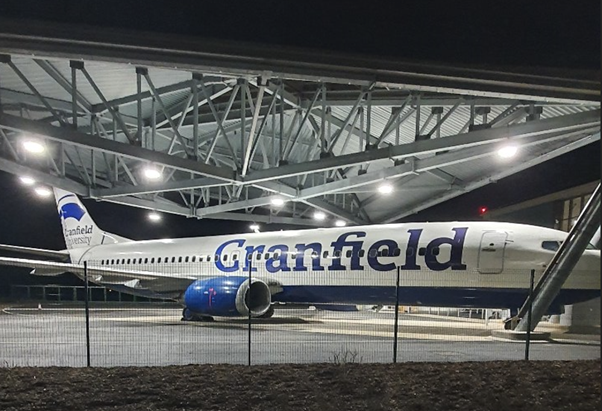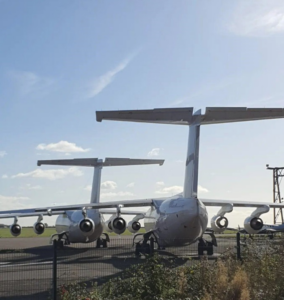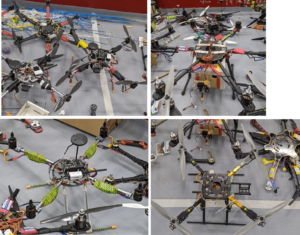My Cranfield journey: Autonomous Vehicle Dynamics and Control MSc
25/01/2022

Hi! My name is Shihab, I am 25 years old and come from London, UK. I’m currently halfway through studying a MSc in Autonomous Vehicle Dynamics and Control.
I completed my BEng in Aerospace Engineering from Brunel University in London. Afterwards, I worked at a Start-Up for roughly a year as a design engineer where I worked with several autonomous vehicles and propulsion systems. That’s when I realised I’d like to work with drones and other aerial unmanned vehicles, especially the ones in the space sector. I found that drones and autonomous vehicles are the future and the fastest growing industry within the aerospace sector. So I started searching for a master’s course related to autonomous vehicles and aerial robotics; that’s when I came across Autonomous Vehicle Dynamics and Control (AVDC).
Fortunately, this course was exactly what I was looking for! It is a combination of aerospace engineering, aerial robotics, artificial intelligence, and control systems. The MSc programme focuses mostly on autonomous aerial vehicles, with UAVs and drone type platforms being a large part of it. However, ground vehicles, space and marine applications can also be experienced in the individual research projects. Many of the concepts seen in the programme are transferable to other autonomous vehicle platforms. Furthermore, our cohort is made up of people from a range of different backgrounds, such as mechanical/mechatronics, electronics, and aerospace engineering. This just shows that anyone can apply to this course since everything is taught from scratch, although having some experience or a little knowledge is always useful. Before starting this course, I barely had any programming experience, but now I’d consider myself quite proficient at MATLAB and SIMULINK. Prior programming knowledge is not essential, but certainly does help with the assignments.
Cranfield University is also one of the few, if not the only university in the world, that teaches this course. Cranfield has amazing facilities, especially for autonomous vehicles.
There is an indoor flying laboratory where drones can be built and tested. There is also an outdoor facility for autonomous vehicles only.

AVDC contains eight modules, a group project, and an individual research project. We also got to attend a drone training course which provided us with a remote pilot certificate of competence. The modules are split up into two weeks for each module then there is an assignment at the end of the module. So far, we have covered, Introduction to Unmanned Aerial Systems (UAS), UAS Modelling and Simulation, Sensor Fusion, and Autonomous Vehicle Control Systems. I have enjoyed studying all of them since I am quite new to most of the modules, but my favourite module was UAS Modelling and Simulation since I have always wondered how all these sub-systems can work together and how they are designed using MATLAB and SIMULINK.

Some of the drones previously created by students.
Our group project started around November. We had the option between two major topics related to UAV Swarm systems. One was persistent monitoring, and the other was counter UAV. I am in the group that chose persistent monitoring, since it seemed to be more significant to civil applications.
We also had a guest lecture by Kirill Shilov who is the founder and CEO of a successful start-up called Sky Drone. He gave us an insightful lecture into what it is like to work with autonomous systems in the industry, what their work entails and what companies they work with. This was a fascinating lecture as a lot of my course members including myself were not quite sure about what career paths to take after graduating. I have really enjoyed learning about how Sky Drone is working with Cranfield University to create a more efficient way to integrate Air Traffic Control with unmanned aerial vehicles. Sky Drone also presented us with several topics to think about for our individual research project. Next term, I am really looking forward to seeing more guest lecturers and hearing about their companies and how they are transforming the aerospace sector for unmanned aerial systems.
I’d also like to mention that we have a great team of lecturers who are experts in their fields. They are all extremely friendly and approachable. Some of us have followed a few of the lecturers on LinkedIn and speak to them there instead of via email. We have a very small group, so lectures feel almost like 1 to 1 sessions meaning that students gain a lot more knowledge from the lecturers.
Outside the classroom, Cranfield University has many facilities for taking part in sports, recreational and social activities. There is a sports centre which includes a gym, two fields (one for everyone – including cricket, football, and rugby and one just for 11-a-side football), plus four tennis courts, which is an ideal way to relax away from academic work and meet new people. There is also a small student union that organises regular events for students. Cranfield has put much effort into alternatives for students to socialise and have fun.
Categories & Tags:
Leave a comment on this post:
You might also like…
Keren Tuv: My Cranfield experience studying Renewable Energy
Hello, my name is Keren, I am from London, UK, and I am studying Renewable Energy MSc. My journey to discovering Cranfield University began when I first decided to return to academia to pursue ...
3D Metal Manufacturing in space: A look into the future
David Rico Sierra, Research Fellow in Additive Manufacturing, was recently involved in an exciting project to manufacture parts using 3D printers in space. Here he reflects on his time working with Airbus in Toulouse… ...
A Legacy of Courage: From India to Britain, Three Generations Find Their Home
My story begins with my grandfather, who plucked up the courage to travel aboard at the age of 22 and start a new life in the UK. I don’t think he would have thought that ...
Cranfield to JLR: mastering mechatronics for a dream career
My name is Jerin Tom, and in 2023 I graduated from Cranfield with an MSc in Automotive Mechatronics. Originally from India, I've always been fascinated by the world of automobiles. Why Cranfield and the ...
Bringing the vision of advanced air mobility closer to reality
Experts at Cranfield University led by Professor Antonios Tsourdos, Head of the Autonomous and Cyber-Physical Systems Centre, are part of the Air Mobility Ecosystem Consortium (AMEC), which aims to demonstrate the commercial and operational ...
Using grey literature in your research: A short guide
As you research and write your thesis, you might come across, or be looking for, ‘grey literature’. This is quite simply material that is either unpublished, or published but not in a commercial form. Types ...







